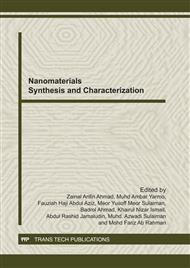p.475
p.480
p.485
p.489
p.494
p.500
p.504
p.510
p.515
Nanotubular Transition Metal Oxide for Hydrogen Production
Abstract:
TiO2, transition metal oxide nanotubes were successfully grown by anodizing of titanium foil (Ti) in ethylene glycol electrolyte containing 5wt % hydrogen peroxide and 5wt % ammonium fluoride for 60 minutes at 60V. It was found such electrochemical condition resulted in the formation of nanotube with average diameter of 90nm and length of 6.6 µm. These samples were used to study the effect of W loading by RF sputtering on TiO2 nanotubes. Amorphous TiO2 nanotube substrate leads to enhance incorporation of W instead of anatase. Therefore for the entire study, W was sputtered on amorphous TiO2 nanotube substrate. TiO2 nanotube sputtered below 1 minute resulted in the formation of W-O-Ti while beyond this point; it accumulates to form a self-independent structure of WO3 on the surface of the nanotubes. TiO2 nanotube sputtered for 1minute at 100W and annealed at 450°C exhibited best photocurrent density (1.4 mA/cm2) with photoconversion efficiency of 2.5%. The reason for such behavior is attributed to W6+ ions allows for electron traps that suppress electron-hole recombination and exploit the lower band gap of material to produce a water splitting process by increasing the charge separation and extending the energy range of photoexcitation for the system.
Info:
Periodical:
Pages:
494-499
Citation:
Online since:
October 2011
Authors:
Price:
Сopyright:
© 2012 Trans Tech Publications Ltd. All Rights Reserved
Share:
Citation:


